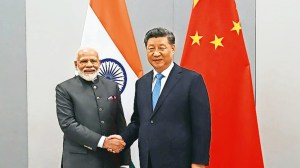In the year of his birth centenary, remembering Kovilan, the writer whose fiction stands apart for its ingenuity
The author of novels such as A Minus B, Himalayam, Ezhamadangal and Thazhvarakal, Kovilan was known for his experiments with language, narration and form
 Kovilan (1923-2010) (Courtesy: KR Vinayan)
Kovilan (1923-2010) (Courtesy: KR Vinayan)Hunger forced Kandanisseri Vattamparambil Velappan Ayyappan to join first the Royal Indian Navy, and later, the Indian Army. Until 1968, he wore the uniform. All through the years, he remained true to his identity as a writer. While serving in the Army, Ayyappan adopted the pen name, Kovilan, which in his words, reflected his Dravidian self. After retirement, Kovilan returned to his village, Kandanasseri, and continued writing. He died in 2010 at the age of 87.
Kovilan was not a prolific writer — he published less than a dozen novels and about 70 short stories. He was not an easy or compelling read either — he experimented with language, narration and form, which appealed only to those who read fiction as a commitment. His sparse prose and staccato sentences stabbed at the reader’s conscience. Not everyone could take the jolt. He wrote his mind, he wrote to disturb. Over the years, he gained a cult following. His birth centenary this year has been an occasion to return to his fiction that stands apart like a lighthouse in a dark, brooding seascape.
Kovilan started writing in the 1940s. It was a miserable time. World War II had created a shortage economy. It was the Quit India Movement that energised people across India, its echoes reaching Kandanasseri as well. When news of Mahatma Gandhi’s arrest reached his village, young Ayyappan, then a student of Sanskrit at Pavaratty Sanskrit College, ended his formal studies. The misery at home forced him to look for jobs. War demanded young blood. Kovilan was willing. He was decommissioned when the war ended. By then, he was a published writer. His first novel, Broken Hearts (Thakarnna Hridayangal), appeared in print in 1946. It captured the poverty and desperation that prevailed in the early 1940s. A distinct voice could be discerned even in this early work. Broken Hearts was centered on hunger and death, two issues that haunted Kovilan all through his writing career. The structural violence behind hunger is most visible in his short fiction (“Ra“, “Payasam“, “Ee Jeevitham Anathamanu“, among them). In his introduction to Kovilan’s Collected Stories, KA Mohandas writes, “The essence and success of Kovilan’s stories is the chemistry that turns violence to empathy”.
The two decades that Kovilan spent in the Army left an indelible mark on his fiction. He wrote a series of novels and short stories that documented life in the barracks. These novels — A Minus B , Himalayam, Ezhamadangal and Thazhvarakal — came to be clubbed as army fiction. Army fiction emerged as a distinct genre in Malayalam in the 1950s and ’60s. Kovilan, Parapurathu (K E Mathai), Nandanar (P C Gopalan) and Ekalavyan (K M Mathew) constituted a quartet of writers who opened up the world of the soldiers to Malayali readers. They worked in the non-commissioned ranks, and the stories that they narrated were of the working class drawn into the force from the most impoverished strata of society. The labelling, Kovilan once complained, diminished the scope of their fiction before readers.
Kovilan, however, was different in the sense that he saw the barracks/Army as a microcosm of India, a subaltern India that had its voice suppressed by both caste and class. Critic EV Ramakrishnan writes, “The Army camp appears in Kovilan’s fiction as the concrete presence of the hierarchical power structure of the State.”
 Kovilan started writing in the 1940s (Courtesy: KR Vinayan)
Kovilan started writing in the 1940s (Courtesy: KR Vinayan)
Another distinguishing aspect of Kovilan’s writing was his persistent search to invent a new language in fiction. Himalayam, which tracks the life of soldiers on the Nathula Road, in the shadows of Kanchenjunga, is a surreal novel, where dreams and hallucinations shape a story of fear and endurance. A Minus B, with its debt to algebra, experimented with the novel form. Kovilan’s “Army novels” introduced a country scarred by hunger, injustice, and social oppression at a time when optimism about the Nehruvian nation had not started to ebb. His fictional characters, mostly men from landless families or small peasantry, did not fit in with the meta-narrative of the new nation-state; their “dissent” exposed the social violence and caste-class faultlines that simmered under the rhetoric of liberal democracy.
If Army life provided a cosmopolitan backdrop to his fiction till the 1960s, Kovilan turned his gaze towards the micro-histories of his desham after retiring from the Army. Thottangal (1970), a stunning novella, was narrated through a stream of consciousness. He invented a new form and an enchanting language that invoked the folk performative traditions, and a Dravidian ethos. In Thattakam (1995), he produced an epic spanning multiple generations against the grand sweep of history. Poet-critic Satchidanandan wrote about Thattakam: “I see my language flower and dance in this work.”
Age could not tame the rebel in Kovilan or his rage. His commentary — he once said that “ours is a criminalised society” — and interventions, stung both the conservative and progressive Malayali. He would inaugurate a convention of Naxalite cultural activists in the ’80s and associate with young activists of new social movements going forward. Beneath the veneer of a provincial writer, there was an uncompromising humanist who never forgot the pangs of hunger and search for justice of his youth.
Photos


- 01
- 02
- 03
- 04
- 05




























